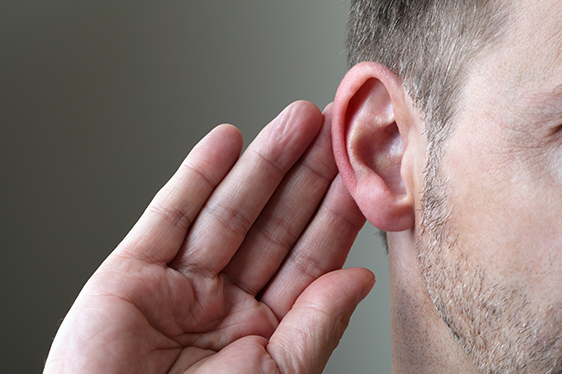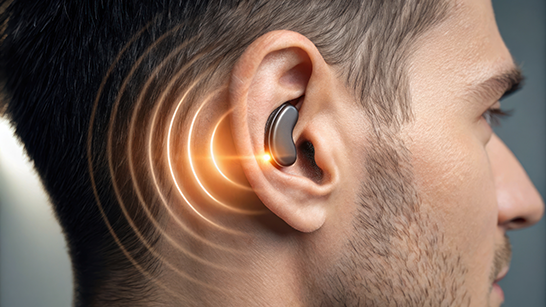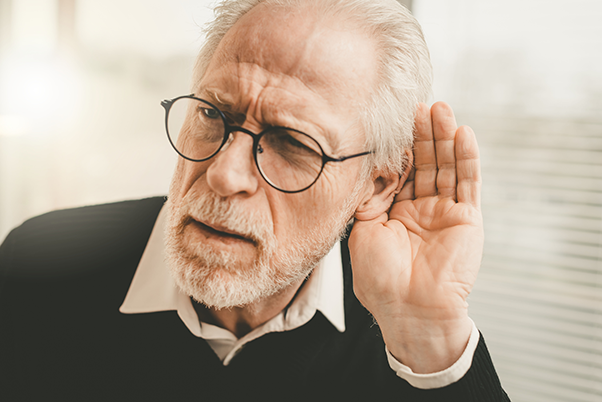Discover what is sensorineural hearing loss, its symptoms, and effective solutions. Our blog provides a comprehensive guide to this common condition.

Sensorineural hearing loss is when there is harm to the inner ear or the auditory nerve. This is a big cause of hearing loss in people and is one of the most common types of hearing loss. It can be different from other types of hearing loss in a few ways.
People who have sensorineural hearing loss may find it hard to hear softer sounds because the sound needs to travel through the ear canal. They may also have trouble knowing what someone says when the sounds are loud. All of this can make it hard to talk with others. It can also hurt their quality of life.
In this guide, we look at sensorineural hearing loss closely. We talk about what the symptoms are, the causes, and the treatment options. This way, you can get to know more about hearing loss and see how to handle it.
What is sensorineural hearing loss?
Sensorineural hearing loss happens when there is damage in the inner ear or in the vestibulocochlear nerve, which people also call the auditory nerve. One type is unilateral sensorineural hearing loss, where the issue is on one side. When this part of your ear or nerve gets hurt, the sound signals do not go to the brain the right way. This can make it hard for people to hear high sounds. A person may feel like speech sounds muffled, and it can be very hard to understand people talking in places where there is a lot of background noise. At first, this hearing loss can be mild. With time, it can get worse and may turn into a permanent hearing loss.
What causes sensorineural hearing loss?
| Cause | Examples |
|---|---|
| Genetics | Inherited conditions like Usher Syndrome |
| Congenital factors | Oxygen deprivation during birth, maternal infections |
| Aging (Presbycusis) | Degeneration of hair cells due to age |
| Noise exposure | Loud machinery, concerts, headphones above 85 dB |
| Ototoxic medications | Aminoglycosides, chemotherapy agents |
Many risk factors can add up fast. This can make SNHL start sooner. Genetic testing, along with good hearing protection, are the key ways to stop this from happening.
How common is it in Australia?
Sensorineural hearing loss is common in Australia. This is because of aging, noise exposure, and some other factors. Research shows that many people have hearing loss as they get older. About one-third of people, who are between 65 and 74 years old, have hearing impairment. When people reach 75, more than half deal with related hearing loss.
Sensorineural hearing loss affects about 5 to 20 out of every 100,000 people each year in the United States. This shows how important it is to get help from a doctor as soon as possible when this happens. A lot of hearing loss also comes from noise exposure at work, especially in construction and other similar jobs. These workplace hazards add to the number of people with this kind of hearing loss every year.
| Sensorineural Hearing Loss in Australia | Key Statistics |
|---|---|
| Age-Related SNHL (Presbycusis) | Affects 1 in 3 individuals >65 years old |
| Sudden SNHL Cases | 5–20 per 100,000 population annually |
| Occupational Noise-induced SNHL | Significant prevalence in high-noise jobs |
The large number of cases shows why we need to have good ways to stop the problem and to make sure people can get help everywhere in the country.
Recognising the Symptoms
You may want to know how to find sensorineural hearing loss early. A few early signs can help you see it. You might have trouble understanding what people say when there is background noise. It can also be hard to hear sounds that are high-pitched. Some things may not sound the same to you as they did before. Early signs like these can mean you have some hearing loss.
Seeing these signs early is very important. When you spot warning signs soon, you can get checked and start help faster. If you have mild hearing loss, you may not notice the real issue right away. That is why it is good to have your hearing tested from time to time. The American Academy of Otolaryngology recommends regular hearing tests. This is extra important if hearing loss runs in your family, you are getting older, or you spend a lot of time in noisy places. When you know and look for the signs, you can get help sooner. This will help your hearing stay good for years to come.
Early warning signs
Noticing the early signs of sensorineural hearing loss can help you take charge and handle it better. You may find that you can’t understand people well when there is a lot of background noise. You might also have trouble hearing sounds at higher frequencies, like the voices of children. Sounds may seem muffled to you, and there could be a ringing noise in your ears. These signs mean there might be hearing loss or some other problem with your hearing.
Some key early symptoms to watch for are:
- It can be hard to follow what people say to you when there is background noise.
- You may have trouble hearing sounds that are high-pitched.
- Speech may not be clear or could sound different at times.
- You might notice a constant ringing noise in your ears.
If you see these signs and they do not stop, it is good to book a hearing test. When you act fast and start using hearing aids or small tools that help, it can do a lot to keep your hearing strong and healthy.
How does it progress if untreated?
Without treatment, SNHL often gets worse. It makes talking with people hard. It can hurt your mood and your social life. After some time, simple things like listening to instructions or enjoying music get tough. As the problem grows, it can lead to depression and being alone. It also may cause you to not do as well at work.
Key Causes of Sensorineural Hearing Loss
Sensorineural hearing loss happens when the inner ear or the auditory nerve is hurt. It is good to know the most common causes of this kind of hearing loss. This helps people stop it or deal with it in a better way.
The key causes include:
- Aging (Presbycusis) – This type of hearing loss happens slowly as people get older.
- Loud noise exposure – Being around loud sounds for a long time or even sudden blasts can damage hearing.
- Genetic factors – Some people are born with conditions that run in the family which can make hearing hard.
- Ototoxic medications – A few drugs, like some types of antibiotics or medicine for cancer, can hurt the inner ear.
- Head trauma – A blow or injury to the head can harm the auditory nerve or the inner ear, leading to hearing loss.
- Infections – Some infections from viruses or bacteria can hurt the nerves in the inner ear.
- Diseases – People may lose hearing because of problems like Meniere’s disease or tumors that grow on the auditory nerve.
Genetics and congenital factors
Sensorineural hearing loss is a common problem found from birth in many places around the world. The main reasons for this hearing loss are genetic causes and several factors during development. A child may get sensorineural hearing loss from genetic syndromes, like Usher Syndrome. Problems before birth, such as lack of oxygen or premature births, can cause this, too. There are more than 100 genes connected with sensorineural hearing loss. These genes can change how the auditory nerve or the cochlea grows and works. Parents should visit specialists and get genetic testing for their child, so they can spot sensorineural deafness early and know what to do next.
Aging (presbycusis)
As people get older, they may start to have hearing loss. This type is often called presbycusis. A key cause of this sensorineural hearing loss is the slow damage to tiny hair cells in the inner ear. These hair cells help let us hear sounds. Over time, things like being around loud sounds and just getting older can do more harm to these hair cells. This can make the auditory nerve not work as well. People with presbycusis can find it hard to hear higher sounds. They may not get what people say if there is a lot of background noise. This can make their quality of life worse.
Noise exposure and ototoxic drugs
Occupational or recreational exposure to loud sounds and some harmful drugs are the main reasons people get sensorineural hearing loss. This can lead to a loss of hearing in some or all people. A person who has a head injury may also get hearing loss from this. Sounds that go over 85 decibels, such as those at concerts or made by big machines, are not good for your hearing. These can hurt the tiny hair cells in the inner ear. When these hair cells are gone, you cannot get them back, so hearing loss can be permanent.
Some drugs, called ototoxic drugs, can make it worse. These drugs can harm how hair cells in the inner ear work. Points to keep in mind include:
- Taking medicines a lot of the time, like aminoglycosides or chemotherapy drugs.
- Being near construction noise or other loud industrial noises for a long time.
- Listening to music or audio on your devices at very high volumes.
It is important to know what these drugs do, and also to use ear protection when needed. Doing this will help keep your hearing safe. It will also protect the tiny hair cells from being damaged forever. Taking care of your hair cells in the ear is good for your hearing in the long run.
How Sensorineural Hearing Loss Differs from Other Types
Sensorineural hearing loss happens when there is damage in the inner ear or the auditory nerve. This damage keeps sound waves from getting to the brain. Conductive hearing loss is different. It comes from something blocking the ear, so sound waves have trouble moving from the basal end of the cochlea. The main difference between these types of hearing loss is where they start, how they get treated, and the way they affect a person’s quality of life.
| Feature | Sensorineural Hearing Loss | Conductive Hearing Loss |
|---|---|---|
| Cause | Inner ear or auditory nerve damage | Blockage or damage in outer/middle ear |
| Reversibility | Usually permanent | Often reversible |
| Treatment | Hearing aids, cochlear implants | Surgery, medication |
Mixed hearing loss happens when you have both sensorineural hearing loss and a conductive problem at the same time. This means you might notice signs of both types of hearing loss.
Sensorineural vs. conductive hearing loss
Hearing loss is a problem that many people across the world have. But there are different kinds of hearing loss you can get. The two main types are called sensorineural and conductive. These are different in what causes them, what signs you will notice, and how the doctors treat them. This list will help you see how they are different, so you can understand them better and know what to do next.
| Factor | Sensorineural | Conductive |
|---|---|---|
| Area | Inner ear/nerve | Outer/middle ear |
| Sound | Distorted | Muffled |
| Reversible? | Rarely | Often |
| Treatment | Aids/implants | Meds/surgery |
Mixed hearing loss explained
Many things can cause mixed hearing loss. This type of hearing loss happens when there are problems with both sensorineural and conductive parts. Damage to the tiny hair cells in the inner ear can start the problem. It can also happen when there are issues in the middle ear or the outer ear. Some causes be ear infections or a buildup of fluid. When both kinds of issues be there at the same time, the hearing impairment can be mild or can get more serious. That is why having full checkups is so important. When you know how these types of hearing loss mix, you can find good treatment options. This can really help people make their quality of life better if they have this type of hearing loss with the tiny hair cells or the middle ear.
Diagnosis: What to Expect
The process to find out about sensorineural hearing loss usually starts with a checkup by an audiologist or an ENT doctor. You will have some hearing tests. These may include pure tone audiometry, speech audiometry, and sometimes tuning fork tests. The bone conduction thresholds may also be checked. These tests help the doctor know what kind of hearing loss you have and how much hearing you have lost. The doctor will also look at your medical history.
This check will look for other things that can cause hearing problems. Some of these can be noise trauma or genetic syndromes. A systematic review like this will help you find what you need to make your hearing better. You will get treatment options that match your needs.
Diagnosis includes:
- Pure-tone audiometry: This test looks at hearing sensitivity that is connected to the base of the basilar membrane.
- Speech audiometry: This is done to see how well you get speech.
- Bone conduction tests: These tests help to know what type of hearing loss you have.
- Medical history review: Here, the doctor will ask about family history, use of any medication, and if there is any noise exposure.
- Physical exam: The doctor checks for any other problems in the ear.
A skilled ENT or an audiologist will use these tools. They help find the level and cause of the hearing loss.
Treatment Options in Australia
Australians who have sensorineural hearing loss have a few options to make life better. They can use hearing aids, cochlear implants, or follow special plans. A hearing aid is helpful when there are damaged hair cells in the ear. A cochlear implant is good for those who lose hearing suddenly or have deep hearing loss. This device sends sound signals straight to the auditory nerve. All of these choices can help to improve communication and quality of life.
| Treatment | Description |
|---|---|
| Hearing aids | Amplify sound, especially speech, using digital signal processing |
| Cochlear implants | Electrically stimulate auditory nerve, bypassing damaged hair cells |
| Assistive listening devices | FM systems, loop systems, personal amplifiers |
| Communication strategies | Lip-reading, visual cues, noise reduction techniques |
Treatment plans are made for each person by the audiologists and ENT specialists. They look at what you need and make a plan that fits just you. This way, the treatment can help you in the best way possible.
Hearing aids and assistive devices
There are many kinds of hearing aids and tools for people who have sensorineural hearing loss. Today’s hearing aids use digital signal processing. This makes the sound louder and brings down background noise. It lets people know speech better. Some tools like FM systems and loop systems send sound right to the person’s hearing aid. These things not only help with hearing loss. They also make the quality of life better and help people join in social activities.
Cochlear implants and surgical interventions
Cochlear implants are a big help for people who have sensorineural hearing loss. This device works by going around the inner hair cells and outer hair cells in the inner ear that do not work. It sends signals right to the auditory nerve. This lets the brain read sound signals. When you use a cochlear implant, the doctor puts small wires, called electrodes, into the cochlea inside the ear. This can help bring back some sounds. It can also help make the quality of life better. A cochlear implant is not right for every type of hearing loss. But it is very good for people who have severe hearing impairment or deep hearing loss. Cochlear implants let people talk and connect better with others they know. This helps in their daily life.
Living with Sensorineural Hearing Loss
Adjusting to life with sensorineural hearing loss and the management of sensorineural hearing loss can feel hard for many people. But there are things that can make it better. You can use hearing aids or cochlear implants. They help boost sound waves. This helps you talk to people, even if there is a lot of background noise. Joining support networks is also good. It gives you a way to meet others who go through the same things. You can share tips and learn how to cope. Getting routine hearing tests is important. These tests will help check if your hearing has changed. They make sure that any problems with hearing loss are found early and treated fast. All these things can help keep your quality of life good.
Communication strategies
Good ways to talk can really help if you have sensorineural hearing loss. You can look at someone’s lips or watch what their face does when they talk. This can help you to know what they are saying. It is also good to be in a quiet place when you talk. A quiet space takes away background noise, so it is easier for you to hear the other person. If you have hearing loss, these simple steps can make talking with others better.
Using tools like hearing aids helps you pick up sound waves better. This lets you hear things more clearly. People who help those with hearing loss say that being patient is very important. They also say it is good to repeat things during talks. This is one way to make sure people with hearing impairment understand you. Doing this helps everyone feel open and friendly when they talk.
Support networks and resources
There are a lot of support networks and resources to help people with sensorineural hearing loss. Hearing loss groups and advocacy groups give easy guides, classes, and events. These groups help people meet others who understand what they go through. There are also online forums. There, people can share their stories and talk about ways to deal with hearing loss.
Healthcare workers can help people by showing them the best treatment options for sensorineural hearing loss. They can also help people find rehab services made just for this type of hearing loss. It is important to get support from family and friends. When people have this kind of help, their quality of life can get better as they get used to new changes.
Can sensorineural hearing loss be reversed?
No, sensorineural hearing loss is usually permanent. However, some technologies can help make hearing better. Hearing aids and cochlear implants are two good options. They can improve hearing loss and help your quality of life.
What are the main risk factors in Australia?
The main things that put you at risk for sensorineural hearing loss in Australia are age, being around loud noises, your family history, and health problems like diabetes and high blood pressure. If you know about these risks, you can get checked early for hearing loss. Doing this can help lower the effect on your hearing health.
How effective are hearing aids for sensorineural hearing loss?
Hearing aids help people who have sensorineural hearing loss or profound hearing loss to hear better each day. These devices will not give you your natural hearing back. But, they make it easier to hear speech and other sounds more clearly. When you use hearing aids, talking with others and joining conversations can feel simpler. All of this can make daily life with hearing loss feel better and help people enjoy their days more.
Is sudden sensorineural hearing loss an emergency?
Sudden sensorineural hearing loss, or sudden deafness, can be a serious issue. It is important to get medical help right away. If you have a sudden hearing loss, you should see a doctor as soon as you can. This can help you have a better chance to get your hearing back. If your hearing loss is fast, getting to a healthcare professional is a must. They will find out the cause and explain the best treatment options for sudden deafness and sensorineural hearing loss.
How can I protect my hearing health?
To take care of your hearing, try not to be around loud sounds too much. If you have to be in a noisy place, use ear protection. It is good to live a healthy life and go for regular hearing check-ups. If you act early, you can stop more harm from happening and feel better too. Try to stay up to date with new ways to save your hearing.






